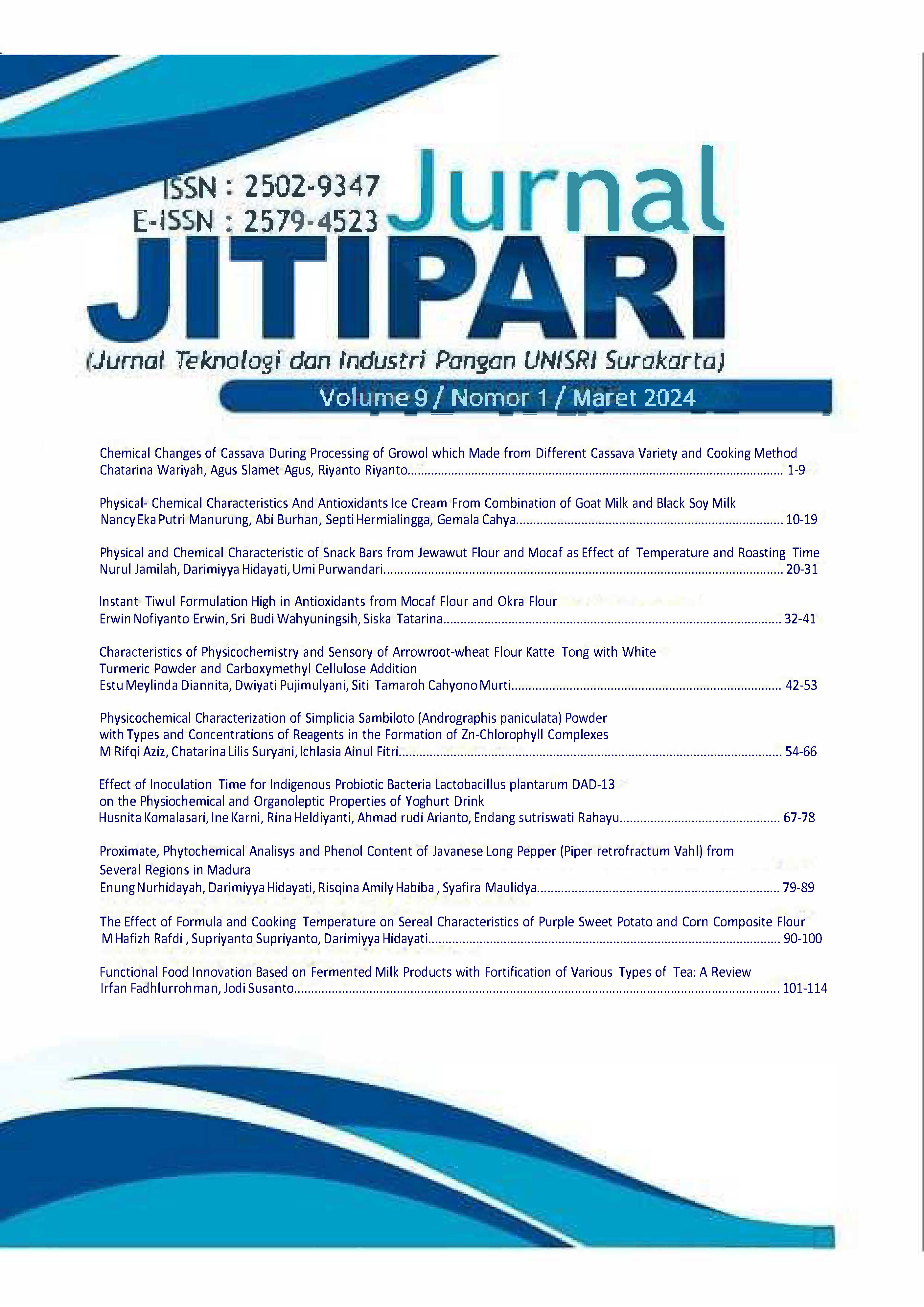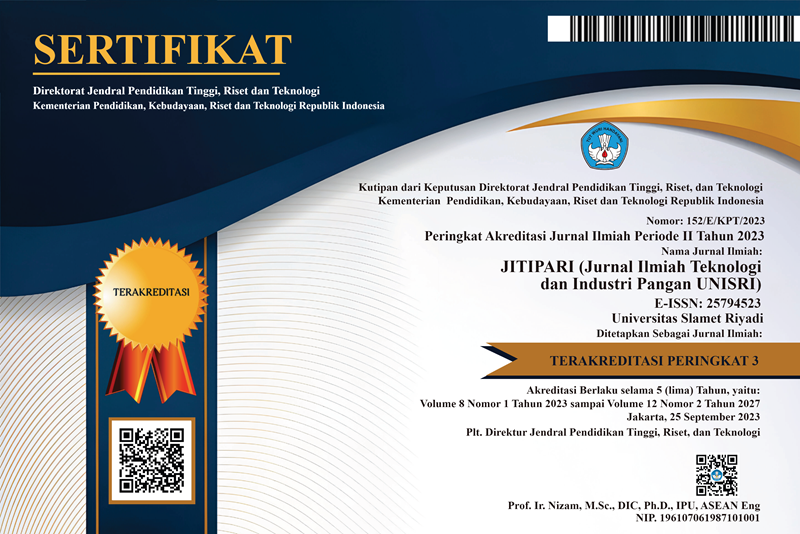Chemical Changes of Cassava During Processing of Growol which Made from Different Cassava Variety and Cooking Method
Perubahan Sifat Kimia Ubikayu Selama Pengolahan Growol yang Dibuat dengan Variasi Varietas Ubikayu dan Cara Penanakan
DOI:
https://doi.org/10.33061/jitipari.v9i1.8793Abstract
Growol is a traditional food made from cassava and processed through soaking/spontaneous fermentation. Growol has the potential as a prebiotic because of its resistant starch content. Currently, growol processing uses the local cassava variety of Martapura. It is cooked by steaming, whereas there are many cassava varieties, and the cooking method also affects the growol characteristics. This study aimed to evaluate the chemical changes of cassava with different varieties and cooking methods during growol processing to obtain growol with the potential as a prebiotic. This research was conducted in a completely randomized design with two factors, namely cassava varieties ("Ketan", "Lanting," and "Mentega") and cooking methods with a variation of: steaming, autoclaving, and pressure cooker. The samples were analyzed for their moisture, starch, and amylose content at each processing stage. Growol with high amylose content was evaluated for its prebiotic index using probiotic bacteria Lactobacillus rhamnosus. The results showed that processing growol with an autoclave of Lanting variety produced a high amylose content of 11.65 ± 2.33% with a prebiotic index of 0.16 ± 0.02.
References
Abioye, V.F., Adeyemi, I.A., Akinwande, BA, Kulakow, P., & Maziya-Dixon, B. (2018). Effect of autoclaving on the formation of resistant starch from two Nigeria Cassava (Manihot esculenta) varieties. Food Research, 2 (5), 468 – 473. https://doi.org/10.26656/fr.2017.2(5).205
Abioye, V.F., Adeyemi, IA, Akinwande, BA, Kulakow, P., & Maziya-Dixon, B. (2017). Effect of steam cooking and storage time on the formation of resistant starch and functional properties of cassava starch. Cogent Food & Agriculture, 3(-), 1296401. https://doi.org/10.1080/23311932.2017.1296401
Afrianto, S., & Wariyah, Ch. (2020). Characteristics and acceptability of growol made with variation of cassava varieties and fermentation duration. Agritech, 40(3), 254-261. https://doi.org/10.22146/agritech.50228
AOAC. (2005). Official methods of analysis of the association of official analytical chemists. Association of Official Analytical Chemists, Washington, D C.
Ashwar, B.A., Gani, A., Wani, I.A., Shah, A, Masoodi, F.A., & Saxena, D.C. (2016). Food Hydrocolloids. 56(-), 108-117. http://dx.doi.org/10.1016/j.foodhyd.2015.12.004
Davani-Davari, D., Negahdaripour, M., Karimzadeh, I., Seifan, M., Mohkam, M., Masoumi, S.J., Berenjian, A., & Ghasemi, Y. (2019). Prebiotics: definition, types, sources, mechanisms, and clinical Applications. Foods, 8(3): 92. DOI: 10.3390/foods8030092
doi:10.1046/j.1472-765X.2003.01398.x
Dou, X., Re, X., Zheng, G., He, Y., Lv, M., Liu, L., Yang, P., Hao, Y., Chen, F and Tang, X. 2023. Effects of lactic acid bacteria fermentation on the physicochemical properties of rice flour and rice starch and on the anti-staling of rice bread. Foods, 12(20), 3818. https://doi.org/10.3390/foods12203818
Eroglu, E.I., & Buyuktuncer, Z. (2017). The effect of various cooking methods on resistant starch content of foods. Nutrition & Food Science, 47(4), 522-533. DOI 10.1108/NFS-10-2016-0154
Hidayat, P. (2020). Kulon Progo typical growol, good staple food alternative for Health. https://www.goodnewsfromindonesia.id/2020/05/30/growol-khas-kulon-progo-alternatif-makanan-pokok-yang-baik-untuk-kesehatan.
Nurdjanah, S., Susilawati, S., Hasanudin, U., & Anitasari, A., (2020). Karakteristik morfologi dan kimiawi beberapa varietas ubi kayu manis asal kecamatan palas, Kabupaten Lampung Selatan berdasarkan umur panen yang berbeda. Jurnal Agroteknologi. 14(02), 126-136
Ogbo, F.C., & Okafor, E.N., (2015). The resistant starch content of some cassava based Nigerian foods. Nigerian Food Journal, 33(-), 29–34.
Oyeyinka, S.A., Adeloye, A.A., Olaomo, O.O., & Kayitesi, E. (2020). Effect of fermentation time on physicochemical properties of starch extracted from cassava root. Food Bioscience, 33(100485), 1-8. https://doi.org/10.1016/j.fbio.2019.100485
Palframan, R., Gibson, G.R., & Rastall, R.A. (2003). Development of aquantitative tool for the comparison of the prebiotic effect of dietary oligosaccharides. Letters in Applied Microbiology, 37(-), 281-284.
Prasetia, K.D., & Kesetyaningsih, T.W. (2015). Effectiveness of growol to prevent diarrhea infected by enteropathogenic Escherichia coli. International Journal of Chem. Tech. Research, 7(6) , 2606-2611.
Putri, W.D.R., Haryadi, Marseno, D.W. & Cahyanto, M. N. (2012). Isolation and characterization of amylolytic lactic acid bacteria during growol fermentation an Indonesian traditional food. J Agric Tech, 13(1), 52-60.
Reza, M.A., Hossain, A., Lee, S.J. ,Kim,C. & Park, S.C. (2016). In vitro prebiotic effects and quantitative analysis of Bulnesia sarmienti extract. Journal of food and drug analysis, 24(-), 822 -830. http://dx.doi.org/10.1016/j.jfda.2016.03.015
Sari, P.M., & Puspaningtyas, D.E. (2019). Skor aktivitas prebiotik growol (makanan fermentasi tradisional dari singkong) terhadap Lactobacillus sp. dan Escherichia coli. Ilmu Gizi Indonesia, 02 (02), 101-106.
Valcheva, R., & Dieleman, L.A. (2016). Prebiotics: Definition and protective mechanisms. Best Practice & Research Clinical Gastroenterology, 30(-), 27-37. http://dx.doi.org/10.1016/j.bpg.2016.02.008
Wariyah, Ch., Kanetro, B., & Riyanto. (2019). Effect of cooling methods and drying temperatures on the resistant starch content and acceptability of dried- growol. Pakistan Journal of Nutrition, 18(12), 1139-1144.
DOI: 10.3923/pjn.2019.1139.1144
Williams, P.C., Kuzina, F.D., & Hlynka, I. (1970). A rapid colorimetric procedure for estimating amylose content of starches and flours. Cereal Chemistry, 47(-), 411-420.
Zheng, F., Xu, Q., Zeng, S., Zhao, Z., Xing, Y., Chen, J., & Zhang, P. (2023). Multi-scale structural characteristics of black Tartary buckwheat resistant starch by autoclaving combined with debranching modificatio. International Journal of Biological Macromolecules. 249(126102), 1-15. https://doi.org/10.1016/j.ijbiomac.2023.126102
Downloads
Published
How to Cite
Issue
Section
License
Copyright (c) 2024 Chatarina Wariyah, Agus Slamet Agus, Riyanto Riyanto

This work is licensed under a Creative Commons Attribution-ShareAlike 4.0 International License.
Authors who publish this journal agree to the following terms:
- Authors retain copyright and grant the journal right of first publication with the work simultaneously licensed under a Creative Commons Attribution-ShareAlike 4.0 International (CC BY-SA 4.0) that allows others to share the work with an acknowledgement of the work's authorship and initial publication in this journal.
- Authors can separately make additional contractual arrangements for non-exclusive distribution published by the journal (e.g., publish it in a book), with an acknowledgement of its initial publication in this journal.
- Authors are allowed and encouraged to send their work via online (e.g., in the institutional repositories or their website) after published by the journal.










